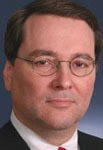An Article Out Loud Flashback from the Domestic Preparedness Journal, October 26, 2016.
Various drills and exercises highlight efforts to protect communities against various types of attacks involving transportation, buildings, historic sites, sporting events, and so on. Attacks and hostage-taking incidents around the world expose vulnerabilities that need to be assessed in all communities to determine: what they need to drill, who they need to train, and how they will collaborate across jurisdictions. The lessons learned in this 2016 article are as important today as they were more than five years ago.
Narrated by Randy Vivian.

Thomas J. Lockwood
Thomas J. Lockwood has been Senior Advisor for Credentialing Interoperability in the Department of Homeland Security's Screening Coordination Office since April 2007 and is a member of the department's senior leadership team. Previously, he was the director of the Office of National Capital Region Coordination (ONCRC). Prior to his DHS service, he was the homeland security advisor and deputy director of Maryland's Office for Homeland Security, where he served on several executive boards including the U.S. Attorney Maryland District's Anti-Terrorism Task Force, the Department of Homeland Security's National Capital Region Senior Policy Group, the Maryland Maritime Security Group, the Maryland Terrorism Forum, the Washington Council of Government's National Capital Region Emergency Preparedness Council, and the National Emergency Management Association's Homeland Security Committee.
-
Thomas J. Lockwoodhttps://domesticpreparedness.com/author/thomas-j-lockwood
-
Thomas J. Lockwoodhttps://domesticpreparedness.com/author/thomas-j-lockwood
-
Thomas J. Lockwoodhttps://domesticpreparedness.com/author/thomas-j-lockwood
-
Thomas J. Lockwoodhttps://domesticpreparedness.com/author/thomas-j-lockwood

Peter LaPorte
Peter LaPorte is an independent consultant in homeland security, emergency management, with a focus on risk and vulnerability assessment. He is a recognized leader in the emergency management field, with over 25 years of successful public safety executive experience within state and local governments. He served in multiple senior executive posts including: executive director of two state emergency management agencies, emergency management director for one of the largest public transit systems in the country, and New York City deputy police commissioner, the largest police department in the United States. He is professionally recognized for development and implementation of innovative and effective policies and programs. He has vast experience in creative problem-solving methods, crisis management, continuity of operations, strategic legislative and media outreach, and communications. He has coordinated six presidential-declared disasters, including floods, Hurricane Isabel (the most expensive disaster in Washington, D.C., history) and the District’s responses to the 9/11 events and the anthrax incident one month later. He also implemented a community-based emergency management program in 39 neighborhoods of the city.
-
Peter LaPortehttps://domesticpreparedness.com/author/peter-laporte







